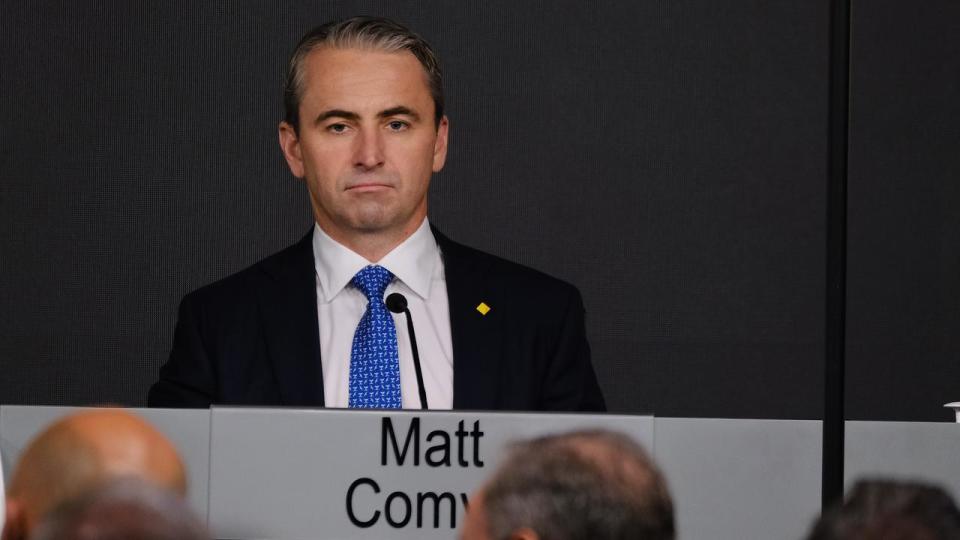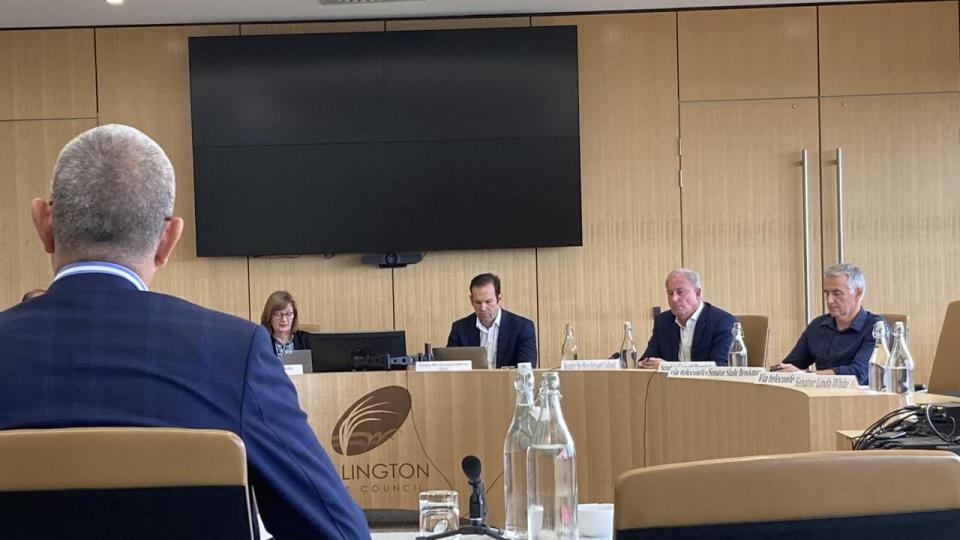‘Make you stay’: Threat to major banks

The bosses of the big four banks are facing a grilling from Senators at an inquiry into rural and regional branch closures, amid accusations they are abandoning country Australia.
The chief executives of Commonwealth Bank, ANZ, NAB and Westpac are appearing before the inquiry, which is being run by the Senate committee on rural and regional affairs and transport, at Parliament House in Canberra on Wednesday.
NAB accused of recording “misleading” data to justify branch closures
Labor Senator Linda White has accused National Australia Bank of recording “misleading” statistics to justify branch closures that were in well used.
Senator White accused the bank of failing to capture general business activities, including signing documents or changing account details, rather than just measuring cash transactions when determining branch closures.
“Don’t you think it’s a bit misleading though that you haven’t given the true picture you just use. You use statistics that are very limited to justify closing branches,” she said.
NAB executive Krissie Jones responded, saying “it’s not a formula that we use” when determining branch closures and that Westpac monitored foot traffic.
NAB chief executive Ross McEwan knocked back Senator White’s suggestion, arguing that Westpac was not “looking for reasons to close branches”.

“We are there to service our customers but there comes a point where not enough people are coming in to make that service viable.
“That is just one factor we look at when we make a broader decision around the future of a branch.”
NAB is the only big four bank who has not promised to pause closures while the inquiry is being undertaken.
Mandates for rural presence floated
Senators conducting the inquiry have touted potential recommendations to mandate community consultation when banks consider a branch closure, or to require banks to maintain a rural presence as part of their licence obligations.
Speaking to the committee, Labor senator Linda Watt asked executives if their banks took issue with potential mandates.
“ Would you have a problem? … We might make you stay in regional area, we might suggest that your license should say you have to have a significant footprint in regional areas,” she said.
NAB chief executive Ross McEwan hit back against the proposal, arguing mandates did not align with customer usage and the Bank@Post scheme would provide a greater number of service outlets than physical branches.
“I would think that you need to consider what are you trying to enshrine into Australia? … It sounds like a world … that would never change but it is changing dramatically,” Mr McEwan said.

“I’d be very careful before enshrining something of like a number of branches into a banking license.”
Mr McEwan said under the Bank@Post scheme, NAB had 3400 locations nationally which was more than three times higher than the number of physical branches it had at its peak.
However, the service offering under the Bank@Post scheme is more limited than a branch’s offering.
Earlier, CBA boss Matt Comyn also pushed back on the proposal, arguing the bank’s agreement to maintain its presence in regional Australia through to 2026 would ensure adequate consultation.
Mr Comyn said that competitor closures offered CBA a commercial opportunity to win over more personal and business customers in regional and rural Australia.
“We are hoping to be able to derive, candidly, a commercial return from persisting in that footprint,” Mr Comyn told the committee.
However, Mr Comyn also cited changing customer preferences would dictate how the bank responded in the future.
“I do think it can’t be lost … the extent to which banking preferences have changed over time,” he added.
Westpac accused of failing to meet social licence
Westpac chief executive Peter King has faced accusations of overseeing the closure of branches that continued to turn a profit while the bank posted strong profit results.
But Mr King defended the decision on the basis of limited customer usage at branches while digital use soared.
“Like many areas of the economy, the way people want to bank has changed over time, and is continuing to change,” he tells the committee.
“We must, at times, make difficult decisions on legacy branch locations that are under-utilised by customers.”

Mr King cited that 96 per cent of transactions from Westpac customers are now digital, and customers who only use a branch represent around 3 per cent of the bank’s 13 million customers.
“Whether that is a farmer doing their banking on an iPad from a tractor, whether it’s a small business using tap-and-go technology at the local market, or whether it’s a family signing a mortgage at home [online],” he said.
In response LNP senator Gerard Rennick accused Westpac of failing to meet its social licence.
“I get that economies of scale are important, but it shouldn‘t come at a cost of declining services in regions that are still very profitable … you’re taking advantage of these smaller communities are you not?” senator Rennick said.
“We know that you‘ve had double digit returns on equities for decades – you’re not meeting your social licence.”
Accused of shifting costs to Australia Post, through the Bank@Post scheme, Mr King cited Westpac’s $200 million investment in the scheme, and claimed “we do not close a branch if there is no alternate Bank@Post in town”.
CBA branch network “unsustainable”: Comyn
Commonwealth Bank boss Matt Comyn kicked off proceedings, claiming that the cost of running its 728 branches – at a cost of $1bn a year – to sell loans and manage cash transactions was becoming increasingly unsustainable as customer demand diminished.
“Transporting and making cash available around our vast country involves the considerable expense of logistics and security,” Mr Comyn said.
“We estimate that continuing to support distribution and availability of cash costs CBA approximately $400 million each year – which works out to roughly $40 for every one of our 10 million customers. Many of our customers don’t use cash though – and these customers cross-subsidise those that do.”

Cash transactions have plummeted across the CBA network in recent years, falling from 43 per cent five years ago to 15 per cent today.
At the same time, customers transact more than $18bn through the CBA app, an increase of 64 per cent.
In response to the inquiry, CBA paused all regional bank closures until the end of 2026.
“As time goes on, it becomes unsustainable to invest substantial resources keeping expensive services that fewer and fewer customers use,” Comyn said.
Mr Comyn also issued a plea for rural and regional customers to bank with CBA if they valued the service in their local communities.
“Our decision to pause rural bank closures is predicated on customers and communities valuing our decision to stay,” Mr Comyn said.
“So for other local councils, small businesses, farmers, homeowners and regional areas, if you value CBA supporting your communities, we will be delighted to serve you.”

Effects of branch closures
According to estimates from the Financial Sector Union, in the five years to June 2022 over 1600 bank branches were closed across Australia, with a disproportionate number of these branches located in regional and rural Australia.
Without government intervention, it appears that this trend will continue as customer demand switches to online banking.
The big four banks have previously argued that online banking and their service offering through Australia Post are adequate replacements for the closure of bricks and mortar branches.
The inquiry has previously heard from community leaders, small businesses and councils in regional rural areas.
Witnesses have told the inquiry that regional banking is crucial for small business and community organisation operations.


